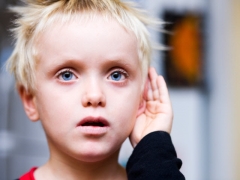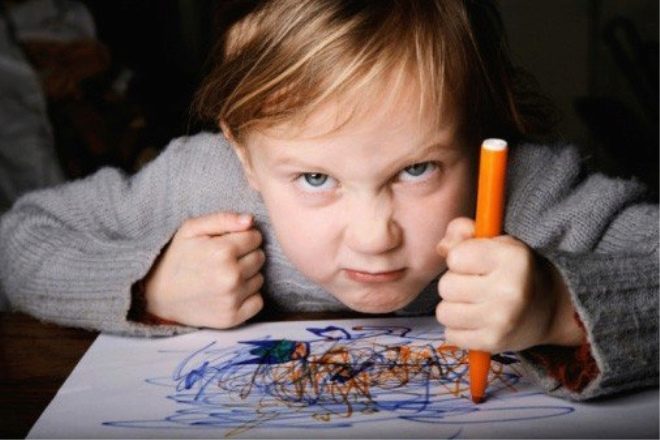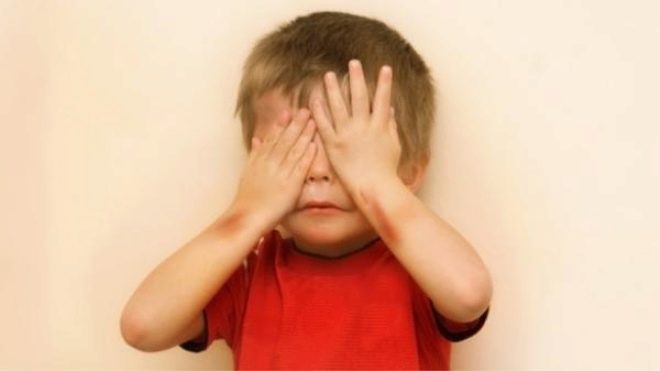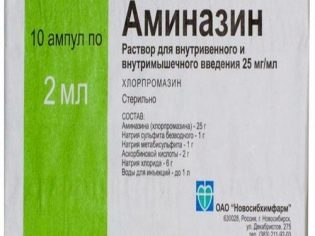Symptoms and signs of schizophrenia in children
Schizophrenia is extremely rare in children — statistics show that in children one child in fifty thousand gets sick. However, the problem is aggravated by the fact that it is very difficult to recognize the illness in early childhood, because it is not a physical defect, which is immediately obvious. At an early age, the manifestation of the disease may go unnoticed, and after all, timely diagnosis could help the little patient. It is necessary to consider in detail the symptoms and signs of this disease in children.
The reasons
Like any other disease, children's schizophrenia is caused by certain factors leading to the development of the disease. At the same time, scientists could not establish the whole range of reasons - there are only factors that increase the risk of morbidity, but do not mean one hundred percent probability of such an outcome.
The main reason is considered to be a genetic predisposition, namely - disruption of the gene structure. However, no one can say when this factor will play its role, because congenital inherently schizophrenia manifests itself only under the influence of a certain catalyst.
It is more likely to diagnose the illness of a newborn soon after birth if the catalyst was an event that occurred when the child was still a fetus - for example, umbilical cord entanglement, mitochondrial insufficiency, other pathologies of pregnancy and complications during childbirth.
In most cases, the first signs are observed much later, being caused by viral infection of the nervous system or severe stress. Wherein the coincidence of even a few of these factors does not at all mean that the child will fall ill with schizophrenia.
Being a disease of a genetic nature, schizophrenia is not transmitted in any way, except by inheritance.
At the same time, parents with gene disorders may be born completely healthy children, and vice versa - the disease in a completely healthy family may first manifest itself in a baby who has received a gene disorder not as a legacy, but as a result of his own pathology.
Signs in babies
In some cases, it is possible to determine obvious mental disorders in a baby before he is 2 years old. The most obvious symptoms are strange behavior: for example, a well-focused view from birth, as if the child was looking at a non-existent object. And this despite the fact that many babies just do not know how.
There are also reverse examples when a child does not react at all to moving objects. Such children sleep very little - just a few hours. They react sharply to noise and cry more often than others - with general lethargy.
With the further development of the child, the pathology becomes more pronounced. Typical symptom of schizophrenia - delayed speech and motor development, although by themselves they still do not say anything. The movements are very noticeable awkwardness and slowness, in addition, these children usually do not know how to build interpersonal relationships.
In general, the behavior of the kids looks very eccentric. Their past lethargy, observed in the first months of life, gives way to easy excitability, a tendency to aggression and cry, but at the same time - a relative coldness in relation to parents. Such a child is able to get carried away with his studies, even to obsession, and in games he usually does not look for a company, and he doesn’t even think about the interests of others.Sometimes schizophrenia is accompanied oligophrenic defect, which is characterized by low memory capabilities and general naivety.
Disease progression
If children get schizophrenia, it usually happens at the stage of preschool age. This especially complicates the diagnosis, since almost all of the symptoms mentioned do not themselves indicate schizophrenia, but are abnormalities within the normal range, because each child develops individually.
The situation is further aggravated by the fact that more than two thirds of all children with schizophrenia experience illness in the form of seizures. It does not appear stable, whereas the continuous development of the disease is observed only in every fourth little patient.
One out of every three children with schizophrenia suffers from its malignant form, which is characterized by a high degree of concomitant oligophrenia.
For unknown reasons, there are boys at particular risk — girls constitute only a quarter of all patients of this type. In addition, it is in boys that the disease progresses, albeit sluggishly, but steadily, whereas girls differ in more pronounced, but still not constant attacks.
Specificity of the malignant form
The malignant form of schizophrenia is rightly considered the most severe, because it does not just slow down the development of the child, but literally turns him backwards. With the appearance of the disease at a very early age, suspicious processes become noticeable at the age of about a year - and acquire final form by the age of 5-7 years. Although in severe cases, the formation of negative symptoms occurs very quickly.
First noticeable total extinction of the emotional background. For kids, it is usually characteristic not to be discouraged, they quickly forget resentment and rejoice in life again, but for a sick with malignant schizophrenia, cheerfulness is alien. The child withdraws into himself, he is no longer interested in what is happening around him, even meeting his parents does not cause him joy.
Gaming activity is increasingly slipping into a primitive, children's negligence with time, not only does not disappear, but is aggravated. The kid does not perceive everything that is new so much that any changes can be almost the only factor causing strong emotions in him - negative ones.
Speech activity is also falling. A well-spoken child begins to be limited to short and simple phrases, then his pronunciation deteriorates, and then he may stop talking altogether. The regress touches and movements - even if the kid already knew how to dress himself, in terms of hand motor skills he gradually returns to the level of a child of 1-1.5 years. It is likely regular repetition of some simple, unconditional movement - like rocking.
With the continuous flow of the malignant form of schizophrenia, the described regression is inevitable. If it manifests itself in the form of seizures, these symptoms are present in two out of three young patients.
Catatonic symptoms
One of the most common concomitant schizophrenia disorders is catatonia, that is, a clear impairment of motor activity. It is not always expressed as a decrease in activity - instead of a stupor, unreasonable excessive arousal may appear. Frequently, there is also a very sharp “regime change”.
If the striking passivity simply scares, then anomalous arousal has very specific risks, such as unjustified aggression and a penchant for impulsive behavior. Characteristically, the catatonic syndrome can develop on its own, without associated mental disorders. Its typical features are:
- Trampling on the spot, intermittent traffic without a specific goal, or a walk without a certain rhythm, somewhat reminiscent of driving a car with a novice driver who has not yet mastered the gearbox. This also includes many hours of chaotic walking, accompanied by a dispersed look that does not prevent the patient to successfully avoid any obstacles in his path.
- The situation when the child suddenly "turns off": just that he was hyperactive and very mobile, and after a moment, he was already completely exhausted.
- Spontaneous waking in the middle of the night - without the ability to quickly fall asleep further.
- In severe cases - destructive hyperactivity, when a virtually unreasonably angry child is able to purposefully cause physical harm to himself and others, as well as to break any surrounding objects.
Perception disorders
A typical condition for most children with schizophrenia is indifference to what is happening around. At the same time, indifference literally to everything sharply contrasts with the illogical, but very noticeable hobbies of some particular subject, occupation or topic.
Very characteristic is also hallucinatory perceptionwhen a little patient sees and tactilely feels something that is not really there.
Such irrational sensations cause the child to fear and often develop to the extent of a full-fledged phobia, which increases with the onset of the evening.
In the daytime, fear and distrust are also present, but they are more directed towards real-life objects — for example, unfamiliar surroundings or people. The anxiety of the child is accompanied by the rejection of food and games, as well as the desire to be as close as possible to the mother.
Experts have noticed: if fear is caused by a certain real factor, then eliminating it generally improves the condition of the child.
The described symptoms have externally expressed features: open mouth and wandering, dispersed gaze. Continuous schizophrenia is a 100% guarantee of perceptual disorders, but in more than a third of patients with an episodic form, such mental disorders are not observed.
Diagnostics
Since childhood schizophrenia is still not an incurable disease, it is very important to diagnose as soon as possible and accurately. Even if the child is not cured as a result, it will not work, only with the help of a correct and timely diagnosis can at least partially reduce the adverse effect on the baby of all the symptoms described. At the same time, doctors most often confidently determine schizophrenia only at the youngest school age, up to 12 years old, and even then only by the results of a large inpatient examination.
There are several difficulties that prevent the rapid detection of schizophrenia. Firstly, many of the symptoms of this disease can really be just the features of a character or individual development. They do not indicate a disease. Secondly, many mental illnesses have a very similar set of symptoms, but they also suggest completely different treatments.
Thirdly, such a bright sign of mental disorders, such as hallucinations and false perception, can not be observed from the outside - only the patient himself can tell. At the same time, children of preschool age are already far from always capable of a detailed, detailed story; schizophrenia also contributes to a decrease in speech activity.
In such situations, specialists usually carry out complex diagnostics, designed not so much to confirm schizophrenia itself, as to check the possible presence of those signs that could indicate a different nature of the disease. As a result the initial diagnosis may change several times, which reduces the effectiveness of treatment.
Often, even experienced doctors confuse schizophrenia with autism, since at the beginning of their development they are really very similar. However, schizophrenia more often not manifested before 3-4 years, it is characterized by a gradual exacerbation of violations. Autism usually formed by two years and is a sharp degradation, but with the subsequent development, albeit very slow.
At this point, you need to pay special attention, because the child himself will not tell. The doctor does not have the opportunity to observe the patient as regularly as the parents do, so he will take his conclusions from the words of the latter.
How to treat?
Doctors say that about half of the children who were diagnosed with schizophrenia at preschool age have every chance of becoming healthy people. For the treatment of this disease, a complex of methods is used, much of which was proposed about one hundred years ago by the famous Russian psychotherapist Vladimir Bekhterev.
Schizophrenia on tomography looks like disorders of the development of the frontal lobe of the brainbut there are many reasons for this, which complicates the treatment. The younger the child, the harder it is to create the right program for him. The range of medications allowed for children is very limited, and psychotherapy is not sufficiently effective because of an insufficient level of understanding of the language.
In preschool age, schizophrenia is usually not so much treated as it is held back - with the help of permitted drugs (in moderation). In any case, the specialists should explain to the whole family what they are faced with, what can be done in order to increase the chances of a positive outcome. Healing effect can even give a properly organized environment. The treatment takes several years but when you connect psychotherapy at a certain age, the result becomes more and more noticeable, and the same inpatient procedures do not have to be performed very often.
When treating schizophrenia, medication is often prescribed. sedative - for example, aminazine and lithium preparations, soothing both the psyche and motor activity.
To enhance the effect of their complement anticonvulsants, as well as antidepressants and antipsychotics.
A very important role can play behavioral psychotherapywhere the child will be taught to cope with their own experiences and to establish contacts with others. The overall relaxing effect and the necessary positive emotional outburst gives therapy in the form of animal contact. In the restoration of disturbed speech will help profile specialist - speech therapist.
Tips for parents
Numerous reviews of parents confirm that the right atmosphere at home can ease the sickness of the sick child. Such a disease in a baby can be a serious challenge for parents. Many are simply afraid of their own child and are trying to pass it on to doctors.
With the typical symptom of this disease (unreasonable phobias), it is family warmth and comfort that are very important. Those families who do everything to ensure a small patient a happy childhood, bring him closer to recovery.
In order not to harm and help the child, follow the following rules:
- Children in general tend to invent non-existent things, but healthy kids do it consciously, and for people with schizophrenia this is part of their reality. Trying to convince the child that his fears do not exist, you will only push him away, because he really sees what he is talking about.
- Since any changes in the life of a child with schizophrenia are perceived by him with bayonets, find the conditions that suit him, and make them a daily schedule, from which you can not deviate.
- Patients of this type are very self-contained, they are not interested in communication, but it must be provided for recovery. This will have to parents. You can do it yourself or with the help of a psychologist.
- When a child begins to realize that he is somehow not so, it is necessary to ensure communication with other families, where there are children like that.This will help both the kids themselves and their parents.
- Due to the high risk of severe fatigue, do not overload the child even with useful activities - like studying.
Thanks to the described actions, even among those adolescents who could not be cured, a strategy of adaptation to their own singularity is developed, allowing them to go to a regular high school.
All about the symptoms and signs of schizophrenia in children, as well as its diagnosis and treatment, see below.
































